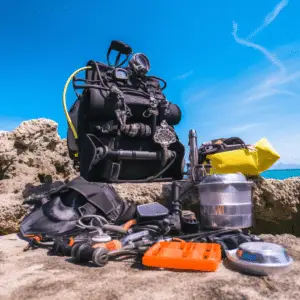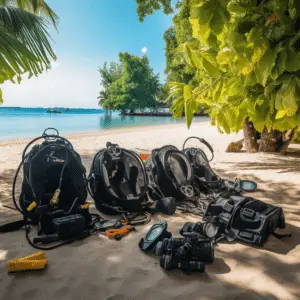Traveling with dive gear? Preparing ahead is essential! Here are some tips to help you out:
- Check the baggage policies of your airline. Be aware of size, weight and number of pieces of luggage. That way, you won’t have any unexpected fees or difficulties!
- Get a sturdy and reliable dive gear bag. It’ll protect your equipment and make it easier to transport. Look for one with padding and compartments.
- Pack your dive gear strategically. Place delicate items in the center and use protective covers for cameras or lights. Vacuum-seal bulky items like wetsuits or drysuits.
- Don’t forget to bring a repair kit. You may need it!
- Double-check that you have all required documents. Have your certification cards, medical forms and any paperwork ready.
- Take photos of all your dive gear (including serial numbers) and keep them in a secure spot, like cloud storage. In case your equipment gets lost or damaged, these photos will help with insurance claims.
Planning ahead is key if you want a smooth and hassle-free experience when traveling with dive gear. Follow these steps and enjoy your underwater adventures without stress or complications!
Choosing the Right Dive Gear

Choosing the right dive gear is key for an awesome underwater adventure. Selecting gear that fits your needs and is safe for exploring beneath the water – what could be better? Let’s look closer at the essential items to consider before diving into the depths.
Dive Gear:
- Wetsuits: Keeps you warm in the cold!
- BCD: For balance when diving.
- Regulators: Supply air from your tank.
- Dive Computer: Tracks depth, time & nitrogen levels.
- Mask & Snorkel: Breathing & vision made easy.
- Fins: Help swim faster.
- Weight System: Counteracts other gear’s buoyancy.
It’s important to choose gear that fits, and is made with high-quality materials. Experience level, diving conditions, and personal preferences all play a role too.
Diving has changed quite a bit over time. Before, divers used leather helmets with air hoses connected to pumps and compressors. Now, modern diving equipment is much more efficient and compact. Technology has definitely revolutionized the industry.
Packing Dive Gear Properly
- Protect it: Clean and dry all dive gear. Get cases or bags for delicate items like regulators and computers.
- Secure tanks: Empty, open valve slightly, and secure in a tank rack or with tank bands.
- Pack smartly: Put heavier items at the bottom of your bag. Roll wetsuits instead of folding. Stuff small items in boots or fins.
- Fragile equipment: Use shockproof cases or padded dividers for cameras or housings.
- Check airline regulations: Check specific requirements with your airline. They may have weight limits or extra charges.
Pro Tip: Invest in lightweight travel-friendly dive gear. This will reduce the weight of your luggage while ensuring good performance underwater.
Checking for Travel Restrictions and Requirements
Always check travel restrictions and requirements before taking dive gear with you. Here’s a 3-step guide to make it a smooth journey:
- Research your destination. Learn if there are restrictions or regulations on the type of gear you can bring in. Some places may require permits or certifications.
- Read airline policies. Every airline has different rules on size, weight and fees for dive gear. Contact the airline if you have any questions.
- Contact local authorities or dive operators. Get accurate information on what is allowed.
Also, some countries have restrictions on dive gear due to environmental or safety reasons. Do thorough research and plan beforehand.
Pro Tip: Have copies of certifications and permits. They may be needed during your travels.
Tips for Transportation
Hassles may come when transporting dive gear – but the right tips can make it much smoother! Here are some pointers to help:
- Grab a quality gear bag. Durable and waterproof, with padded compartments to keep everything organised and safe.
- Know the airline regulations. Before heading to the airport, check the rules and restrictions airlines have regarding diving gear. Some may require items packed separately, or have weight limits.
- Disassemble and pack wisely. To save space and avoid damage, take apart your dive gear. Put regulators, masks, and fins in different bags or cases to stop them scratching or getting tangled.
- Secure fragile items. Wrap bubble wrap or towels around gauges or cameras. Place them in the centre of your bag, and surround with softer items for extra cushioning.
Don’t overlook local regulations or customs at your destination. Research ahead of time to dodge any unexpected surprises.
Now you know how to transport your dive gear – don’t miss out on incredible adventures! With proper planning and organisation, you can confidently explore new sites. Enjoy!
Safety Precautions
Travelling with dive gear? Keep safety in mind! Here are 3 key points to remember:
- Pack it right: Prioritize organizing your gear, using separate bags or compartments. This will help avoid damage.
- Secure storage: Use locks or secure areas when transporting, so you don’t risk theft or mishandling.
- Regular maintenance: Ensure your gear is in good working condition before travelling. Inspect and service it to minimize malfunctions during your dive.
Plus, check local regulations about dive gear transportation and usage. Here’s a story to emphasize the importance of safety precautions:
A seasoned diver once went abroad without properly securing their gear. On arrival, some essential equipment was damaged due to rough handling during transit.
By following these safety steps, you can make sure your dive gear remains intact and ready for underwater adventures. Enjoy the dive!
Exploring Dive Destinations

Ready for an underwater adventure? Here are some of the world’s top dive destinations and what they offer:
| Destination | Highlights |
|---|---|
| Great Barrier Reef | World’s largest coral reef system |
| Maldives | Pristine white sandy beaches and abundant marine life |
| Galapagos Islands | Unique marine species and volcanic formations |
| Red Sea | Stunning visibility and vibrant coral reefs |
| Bahamas | Crystal clear waters teeming with sharks and colorful fish |
Research and pick your destination based on your interests and skill level. Remember to consider factors like water temperature, access, and local regulations.
In 1927, the Great Barrier Reef was named the first marine park in the world. Since then, many efforts have been made to protect this natural beauty. It’s still one of the most popular dive spots today.
So many wonderful places to explore! Get your gear ready and be prepared for a one-of-a-kind underwater experience!
Conclusion
Traveling with dive gear can be tricky. But, by following a few smart tips, you can have a smooth experience.
Invest in a robust dive gear bag that can handle the rigors of travel. This’ll help protect your equipment from any damage.
When packing your equipment, organize everything properly. For fragile items, like masks and regulators, consider putting them in padded cases or wrap them with soft clothes. Utilize all space efficiently and fill empty gaps with smaller items such as fins or wetsuits.
Before heading to the airport, check the weight restrictions of the airline. Ensure the gear falls within the allowed limits to avoid extra charges or issues at the check-in counter. Additionally, pack essential items like wet suits and regulators in your carry-on luggage, in case your checked baggage gets delayed or lost.
Thoroughly rinse all dive gear after each use. This will help prolong the lifespan of your equipment and prevent corrosion and bad odors. Once rinsed, give time for drying before packing them away.
Lastly, before heading out on a dive trip, double-check your gear. Look for any signs of wear and tear, air hose leaks, or malfunctioning parts. It’s better to detect and resolve any issues beforehand than underwater.
During WWII, scuba diving became fundamental for military operations. The US Navy created the Mark V Mod 1 rebreather system which enabled divers to stay submerged for longer. This invention revolutionized underwater exploration and made way for modern scuba diving gear. Nowadays, advancements in dive gear tech keep enhancing the safety and pleasure of divers around the world.
Frequently Asked Questions
Q: Can I bring my own dive gear when traveling?
A: Yes, you can bring your own dive gear when traveling. However, it’s important to check with your airline regarding their baggage policies and regulations for transporting dive equipment. Some airlines may have specific requirements or restrictions, such as weight limitations or the need to drain the tanks and disassemble certain parts.
Q: How should I pack my dive gear for travel?
A: When packing your dive gear for travel, it’s crucial to properly secure and protect it. Use a durable dive gear bag or a hard-sided case to safeguard your equipment from damage during transit. Make sure to wrap delicate items like dive masks or regulators in soft clothing or towels to provide extra cushioning. Additionally, pack any sharp objects, such as dive knives, separately and declare them to the airline if required.
Q: Are there any restrictions on diving equipment when traveling by air?
A: Yes, there are certain restrictions on diving equipment when traveling by air. Most airlines prohibit the transportation of compressed gas cylinders, including scuba tanks, due to safety concerns. However, you can rent tanks at your destination. Make sure to check with your airline beforehand to understand their specific regulations and policies regarding dive gear.
Q: How can I ensure my dive gear arrives safely at my destination?
A: To ensure your dive gear arrives safely at your destination, consider the following tips:
- Label your dive gear bag or case properly with your contact information.
- Add fragile or special handling stickers if available.
- Choose a direct flight if possible to minimize the risks of mishandling during transfers.
- Upon arrival, inspect your gear for any damage and report it immediately to the airline if necessary.
Q: Is it better to rent dive gear instead of bringing my own while traveling?
A: Renting dive gear can be a convenient option when traveling, especially if you want to avoid the hassle of packing and carrying your equipment. It can also save you from potential damage or loss during transport. However, if you prefer using your own gear, ensure you comply with airline regulations and pack it securely to mitigate any risks.
Q: Can I bring dive gear on a cruise ship?
A: Most cruise ships allow guests to bring their dive gear on board. However, it’s essential to check with the specific cruise line regarding any restrictions or guidelines they may have. Additionally, be aware that space on a cruise ship can be limited, so make sure to pack your gear in a compact and organized manner.
